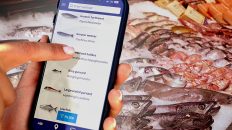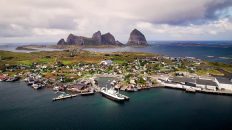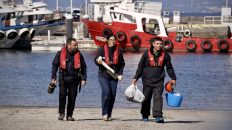Båtsfjord is a remote fishing village on Norway’s northernmost coast, far beyond the Arctic Circle. Though home to just couple of thousand residents, it’s a vital local hub for the fishing industry. Local fishing boat owner Tommy Jonassen set out to seize a brief window between two Arctic storms for a chance of finding a good catch in these cold, unpredictable waters.
“It can be tough, can be tough,” he asserts. “Especially the autumn and winters. Weather is very unpredictable. Very cold. And of course, of course, it can be very bumpy… We work when there is fish to catch. So it doesn’t matter what time of the day it is. Day, night — it’s all the same for us.”
His fishing vessel uses a large net to catch massive amounts of fish at once. A good day could bring in 30 tons of catch. Cod makes the most money, but the nets pull up a mix of fish species. Unwanted fish can’t be just thrown back at sea — each of the species needs to be weighed and logged separately.
Inspections can happen anytime, and any mistakes in catch reporting could have serious consequences, including big fines and reduced quota, as Tommy Jonassen is well aware: “The fishing industry in Norway is strictly regulated. So it’s very important for us to have the exact number of what we catch so we can report it to the government. If we make a mistake, in worst case scenario, they will take the whole catch away from us. So that means that all the work we’ve done catching the fishes is wasted.”
Counting the catch
But how do you weigh tons of different fish quickly and accurately? Usually, fishers estimate the total weight by counting containers filled with fish. But this vessel has a new device designed to make catch counting easier and more precise. Still in development, the catch scanner uses AI to identify fish species, size, and weight as they move along the conveyor belt. The aim is to make the process as automatic as possible.
New digital tools on fishing vessels can do much more than just count the catches. Europe is stepping up its fight against illegal fishing — both at home and around the world. In the next few years, this will lead to major technological innovations in fishery monitoring, control, and surveillance.
Underreporting of catches can lead to overfishing, harming fish stocks and ecosystems.The catch scanner is part of EveryFish, a European projectdeveloping smart catch recording tools. It’s led by Rachel Tiller, Chief Scientist at SINTEF Ocean in Trondheim.
“We need to know what’s going on out there so that we can solve all of this different crises — the climate crisis, biodiversity crisis, we need to have more knowledge about the ocean,” Tiller tells us. “We’re looking at a number of different developments in camera technology and machine vision, artificial intelligence, trying to come up with solutions to put on fishing vessels sensors that can help us to automatically record all the fish that come out of the sea.”
There are many engineering challenges ahead. For catch scanners to be truly useful, they must be highly reliable and accurate. Fishers, controllers, and scientists need to trust the data produced by AI onboard. To meet this goal, EveryFish researchers have developed open-source AI methods to identify fish species and estimate weights.
The engineers work closely with fishers to ensure their solutions meet real-world needs and perform well on rocking boats in cold, salty seas. Elling Ruud Øye, Research scientist, SINTEF Ocean
“It’s really important to get the feedback from the industry, from the vessels, to be able to shape what we are working with here at the lab,” says Elling Ruud Øye, a research scientist at SINTEF Ocean. “If not, we don’t — If we don’t have the kind of feedback done, we might just go in the wrong direction.”
Small scale, hi-tech
To count catches on smaller boats, researchers are developing computer vision systems that can identify and measure individual fish in a pile. This could allow artisanal and hobbyist fishers to scan their catches using CCTV cameras or even smartphones.
The same technology could even guide robotic arms to sort and handle the catch, taking over some of the hardest manual tasks, says Jonatan Sjølund Dyrstad, another research scientist with SINTEF Ocean: “There’s a lot of hard labour in the fishing industry in general, so it’s hard on the shoulders, hard on the back. You have to stay leaned over table enough to work with the fish. And what you can do is you can perhaps automate some of these processes with robotic arms. And the clue to doing so is to have good vision systems that are able to parse and understand the scenes that they’re looking at.”
Onboard surveillance cameras are often used to combat illegal fishing and other violations. In places like Seychelles, monitoring officers regularly review onboard footage to ensure fishers follow the rules. In Europe, video surveillance will have to comply with strict privacy and data protection laws.
“Many fishers are already really sceptical of the system of having some kind of camera on board their vessel, and it’s absolutely understandable, SINTEF’s Rachel Tiller, says. “I would be sceptical as well if my boss wanted to install a camera in my office. So we are developing systems that will automatically blur out identifiable elements of humans, so we can comply with GDPR regulations and also with a sense of personal space.”
The EU will require surveillance cameras on high-risk vessels, as well as satellite tracking systems on all fishing boats.
These tools help European Fisheries Control Agency officers in Vigo, Spain, monitor fishing and coordinate inspections.
“The signal is going to satellite, later down to our systems, and what we have, we can see on the screen,” explains Lina Lendzbergiene, EFCA Coordinator. “Here we have our vessels, here we have fishing vessels, so we can count time – how much we need to get them in position.”
Closing the net on illegal fishing
With more fishing vessels getting equipped with trackers, control centres will have much more data to process. Computer algorithms can help sift through it all and flag anything suspicious.
“We have some automatic tools that can perform some analysis,” Carlos Couce, Control Operations Administrator at EFCA tells us. “For example, for example related with a with a closed area, or the fisheries restricted areas we have, for example, in the Mediterranean Sea. One of these areas is the very well known Jabuka/Pomo Pit area in the Adriatic Sea, where we have some algorithms defined in order to raise some alerts, or some warnings, in case if a vessels is accessing in this area with certain speed which could be associated to a potential fishing activity.”
While digital tools like cameras and AI are valuable additions to fishery monitoring, experts caution they have limitations and can sometimes fail. The EU’s push for stricter oversight combines traditional inspections with these new technologies. The surge of digital data is meant to make fishing more sustainable and fair, according to Sven Tahon, Surveillance Technologies Specialist Officer at EFCA: “I always call it a tsunami of data that will come in. We will have to look at how we work with that data, which technologies we can use to translate this data into usable and actionable outputs. We can for that use artificial intelligence, algorithms, automatic behaviour monitoring tools. All this is very nice. But at the end of the day, despite all this technology, you will still need the professional input from the fishery inspector.”
Digital technology can give fishers handy new tools, so they can spend more time fishing and less time filling forms. It also helps scientists find new ways to protect the health of our oceans, while making it easier for fishery controllers to ensure there’s plenty of fish in the sea for years to come.





